In our part of the world, most of us reach middle age without ever seeing a dead body, making death a subject of fascination. Death is just out of reach, yet it affects us all – it is both universal and indiscriminate. Death – A Self-Portrait, the new exhibition at the Wellcome Collection encourages us to use death as a means of better understanding life.
The Wellcome Collection asks visitors to its website to “Tell us about an object that makes you think of death: a reminder of someone you lost, a family heirloom, something associated with a death itself, or anything else.” And there are many such items on show in the exhibition, just as there are many faces of death:
German Anton Sohn (1769-1840) created a series of 42 hand painted terracotta Dance of Death figures, inspired by a famous mural in the cemetery of a Dominican friary in Basel.
Japanese Izumi Sukeyuki (1838-1920) sculpted a curious snake exploring a skull – an okimono (decorative object) expressing the Buddhist vision of the ongoing existence of the soul, which is thought to undergo perpetual transformation into new states of being. Plus a snake is believed to be reborn every time it sheds its skin.
Metamorphic postcards (c.1900-10) feature whimsical illustrations that are “lent a surreal pathos by the grinning skulls into which they transform, becoming turn of the century interpretations of the vanitas theme.” The phrase ‘vanitas vanitatum omnia vanitas’ comes from the Bible (Ecclesiastes I) and is translated as ‘vanity of vanities; all is vanity’ – a moralistic invitation to dwell on the necessity of eternal salvation, as opposed to the acquisition of worldly goods.
These are just a few of the many and varied pieces on show. But can art help us to cope with the prospect of death? Why are the inanimate objects of burial ritual and mourning universally deemed to have significance? And how can possessions activate memories that assist us in coming to terms with bereavement, and perhaps even our own mortality?
I look forward to hearing your thoughts on this subject – and do feel free to share details of your own actual or suggested ‘objects of death’.

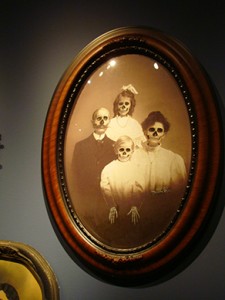
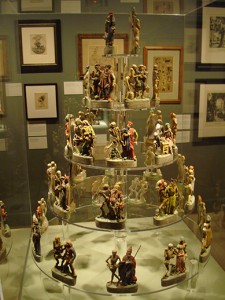
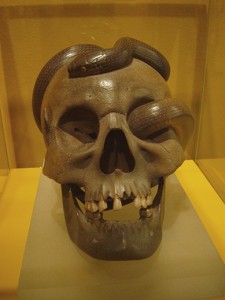
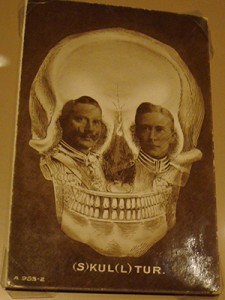
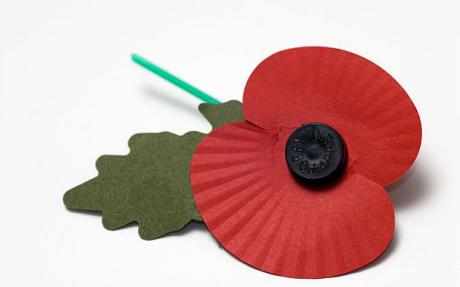







Although slightly off message, the experience of attending a humanist funeral, my first, just a week ago, merits this short comment. As a ‘jury still out’ disbeliever (I’d like to be wrong), the whole business of ‘passing-on’ or ‘over’ has, like most of us I imagine, been a troubling one. The humanist ‘memorial’ I attended was, against my expectations, a moving and satisfying experience focusing, as it did, on the person who had died, not on any afterlife that may follow along. The minister or pastor who conducted proceedings had the quiet dignity and absence of cant that I would hope for when my own time in the bone-orchard rolls around. And the music played, and words spoken were chosen by the lady whose life we were remembering and, yes, celebrating. Perhaps I have always been a humanist; now I am a Humanist.
I rather like the idea of speaking at my own funeral too… I’ve never attended a humanist funeral, Mahlerman, but I did a lot of research on this subject for a book I wrote in 2006. In fact I interviewed people here in the UK and in Africa to ask how they would like to be remembered and what sort of funerals they would like. I also interviewed an inspirational lady called Roslyn Cassidy who runs a company called Green Endings and organises ‘celebration of life’ services according to individual requirements.
Yes, Green Endings do an excellent job.
Being within similar distance of the bone orchard I too have pondered and would opt for a humanist send-off. I have been to a number, and they can indeed achieve the necessary dignity. The orthodox religions undoubtedly have this one worked out, but for unbelievers, and if one is fortunate enough to have the ceremony conducted by someone who has done their research and can extend themselves beyond the rote, then it can be moving and condign.
Quibble, Susan. Ecclesiastes 1, beautiful to the point of mesmerizing, cannot be about dwelling “on the necessity of eternal salvation”, a Christian, New Testament concept. I’ve been haunted by it for years and I’ll get back to you if I ever figure out what is is about.
Point taken, thanks Peter!
Ecclesiastes spares nothing. When he says, “*all* is vanity”, he means it – from the simplest pleasures to the highest piety: *all* is vanity. Amongst the few works I have read, and the fewer that I have studied, I always found Ecclesiastes to be one of the most sublime for its also being one of the most troubling, but I see from the Wikipedia article that Thomas Wolfe put it much better than I ever could:
“[O]f all I have ever seen or learned, that book seems to me the noblest, the wisest, and the most powerful expression of man’s life upon this earth — and also the highest flower of poetry, eloquence, and truth. I am not given to dogmatic judgments in the matter of literary creation, but if I had to make one I could say that Ecclesiastes is the greatest single piece of writing I have ever known, and the wisdom expressed in it the most lasting and profound.”
There’s not much between CofE and humanist, I’d say. But I was brought up RC and my first two childhood corpses were related to that – a bishop, at whose funeral I acolyted, and my grandmother at her wake. Both were like waxworks and frightened me.
Regarding death objects – I suppose there’s two kinds: the ones about death, and the ones to remember the dead. For the latter, we all now have masses of digital photos and videos, which is an interesting new development. Of the former, let’s put in a word for Damien Hirst’s only good bits of art – the shark and the cow.